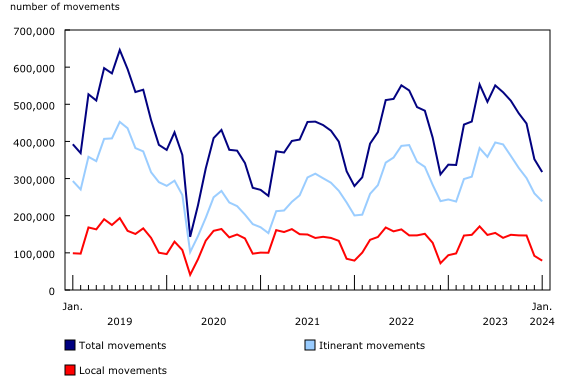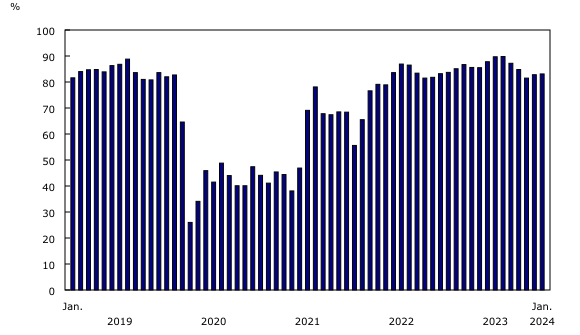Aircraft movement and civil aviation statistics, January 2024
Released: 2024-03-26
Highlights
In January, aircraft movements at Canada's major and select small airports totalled 317,569, down 5.9% from January 2023. Local movements fell 15.7% year over year to 79,012, while itinerant movements declined 2.1% to 238,557.
At the same time, major Canadian airlines flew 6.8 million passengers on scheduled and charter services in January 2024, with the passenger load factor at 83.1%.
Consult the new Aviation Data Visualization Hub to further explore data from Aircraft movement statistics and Monthly civil aviation statistics in an interactive format.
Fewer local movements, while international traffic up
In January, there were fewer local movements year over year in most provinces and territories across the country, with the largest declines reported in British Columbia and Alberta. In British Columbia, Boundary Bay reported a drop of 51.5% in local movements, while those in Abbotsford were down 24.7%. Similarly, in Alberta, Edmonton/Villeneuve had 50.8% fewer local movements, while Calgary/Springbank decreased 21.6%. Reduced flight school activity accounted for most of the decline in movements at these airports.
In January, other international traffic (outside the United States) was up 14.7% year over year, reaching 18,646 movements, and remains above the pre-COVID-19 pandemic level. As indicated by the release "Screened passenger traffic at Canadian airports," the number of passengers screened for international flights also increased in January.
At the same time, transborder movements to and from the United States were up 3.3% to 32,133 in January. There was a notable gain reported at Ottawa/Macdonald-Cartier International (+58.3%), primarily from the addition of commercial passenger flights to several US destinations.
Domestic movements declined 4.4% to 187,778 in January, with much of the decrease attributable to private and smaller operators not classified as Level I to III or foreign carriers.
For the third consecutive month, airports in Ontario reported the highest number of aircraft movements, with 86,959 in January. Toronto/Lester B. Pearson International remained the busiest airport, with 31,499 movements, a 7.4% year-over-year increase.
Major airlines' operating and financial statistics
The seven Canadian Level I air carriers flew 6.8 million passengers on scheduled and charter services in January, 10.9% more than in January 2023 when there were six Level I carriers.
The number of Level I air carriers increased from six in 2023 to seven in 2024, because one Level II air carrier was reclassified to Level I.
The number of passenger-kilometres in January was 18.6 billion and capacity was 22.4 billion available seat-kilometres. As a result, the passenger load factor (the ratio of passenger-kilometres to available seat-kilometres) was 83.1%, a slight decline from the 83.7% recorded in the same month a year earlier.
Each passenger travelled an average of 2 750 kilometres in January, up 1.8% from January 2023.
Level I carriers flew 184,000 hours in January 2024 and generated $2.3 billion in total operating revenue.
Did you know we have a mobile app?
Get timely access to data right at your fingertips by downloading the StatsCAN app, available for free on the App Store and on Google Play.
Note to readers
As of reference month January 2024, Statistics Canada is publishing a new consolidated monthly release called "Aircraft movement and civil aviation statistics." The survey programs which support the new release are:
- Aircraft movement statistics (survey number 2715, tables 23-10-0296-01 to 23-10-0304-01)
- Monthly civil aviation statistics (survey number 5026, table 23-10-0079-01).
The tables associated with the above survey programs remain unchanged and will be updated as usual. Definitions, data sources and methods for each survey program remain available by accessing each survey's respective number.
Consult the new Aviation Data Visualization Hub to further explore data from Aircraft movement statistics and Monthly civil aviation statistics in an interactive format.
The aviation statistics program uses respondent (Monthly civil aviation statistics) and administrative (Aircraft movement statistics) data.
An aircraft movement is defined as a take-off, landing or simulated approach by an aircraft, as defined by NAV CANADA.
An itinerant movement is the initial take-off or the final landing of an aircraft.
A local movement is an aircraft conducting the following airport activities: touch-and-go, stop-and-go, simulated approach without landing, low approach, pull up while on final approach, or missed approach. Local movements are often carried out during training flights (touch-and-go), equipment tests, etc.
The Monthly Civil Aviation Survey covers all Canadian Level I air carriers: Air Canada (including Air Canada Rouge), Air Transat, Flair, Jazz, Porter, Sunwing, and WestJet (including WestJet Encore and WestJet Link). The number of air carriers increased from six in 2023 to seven in 2024, because one Level II air carrier was reclassified to Level I.
The average passenger trip length is calculated by dividing the number of passenger-kilometres by the number of passengers. Trips across Canada and around the world are included in this calculation.
The data in this monthly release are not seasonally adjusted.
Data are subject to revisions.
Contact information
For more information, or to enquire about the concepts, methods or data quality of this release, contact us (toll-free 1-800-263-1136; 514-283-8300; infostats@statcan.gc.ca) or Media Relations (statcan.mediahotline-ligneinfomedias.statcan@statcan.gc.ca).
- Date modified:



